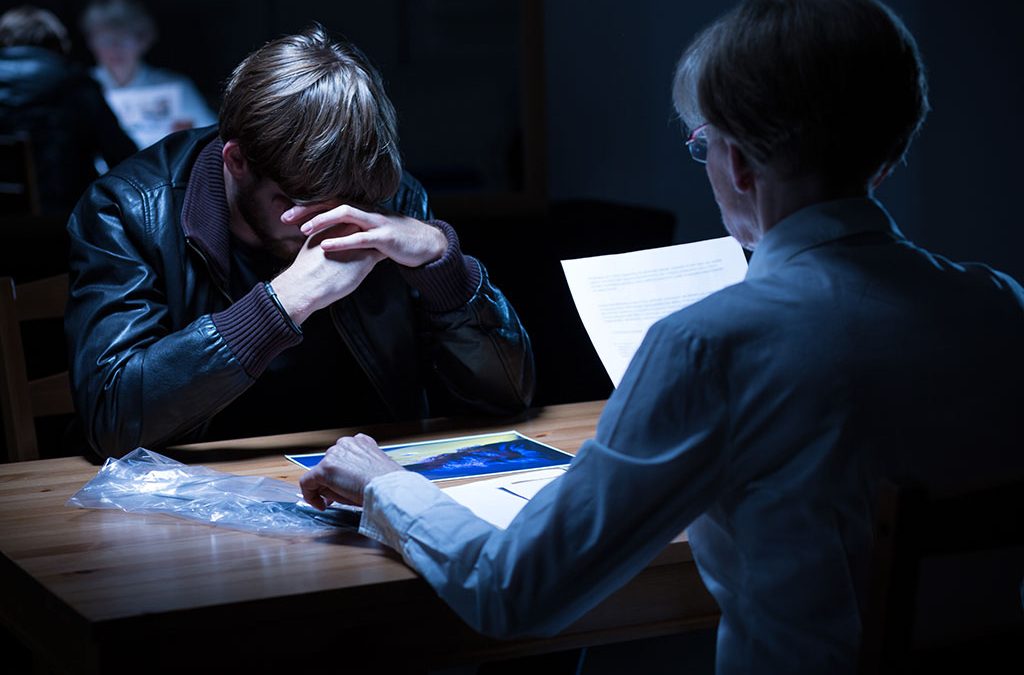The Complexity of the Security Officer's Work (Head of Security) When Conducting an Interrogation to Investigate Suspected Offenses and the Impact of the Surrounding Variables of the Interrogation on the Success of Their Work.
The Work of the Security Officer / Head of Security in Companies and Businesses Is Far from Simple. Among His Various Responsibilities, He Is Required to Conduct Investigations and Inquire Into Unusual Events, Address Suspicions of Irregularities, and Investigate Alleged Violations of Organizational Rules and Various Criminal Offenses Within the Organization for Which He Is Responsible.
Beyond the Professionalism and Experience of the Security Officer / Head of Security, the Conditions Under Which the Investigation or Interrogation Is Conducted Are Also Crucial. The Success of the Interrogation Is Influenced by Many Variable Factors, Including the Location of the Interrogation (In the Interrogation Room — the Security Officer’s Office, or in Many Other Cases, Outside the Interrogation Room), the Atmosphere of the Interrogation Room, the Number of Security Officers Present in the Room During the Investigation, and More.
This Article Will Discuss the Variable Factors Included in the Term "Interrogation Environment" and Their Impact on the Success of the Interrogation or Investigation.
The Atmosphere of the Interrogation Room
As a Rule, the Security Officer Should Aim to Conduct the Interrogation "On His Home Turf," Meaning in His Office or Another Suitable Room That Has Been Equipped for the Purpose of Conducting Investigations. However, In Many Cases, Reality Dictates Different Conditions. In Companies That Operate Nationwide and Have Multiple Locations, the Interrogation is Often Conducted at the Specific Site Where the Incident Under Investigation Took Place or Where the Employee Suspected of Committing the Offense Is Employed. Therefore, in Such Cases, the Security Officer Arrives at the Site, Which Is Essentially the Employee’s Natural Work Environment, and Conducts the Interrogation in the Examinee's Natural Environment or "On the Examinee's Home Turf."
In Light of This Fact, In Many Cases, the Conditions Under Which the Security Officer Conducts the Employee's Interrogation Are Far From Ideal for the Officer, To Say the Least.
Efforts Should Be Made to Adapt the Atmosphere of the Room Where the Investigation/Conversation with the Employee Suspected of Involvement in the Incident Under Review Takes Place to Several Variable Factors:
- The type of offense and the level of involvement of the examinee in the event.
- The capabilities and experience of the security officer who serves as the investigator in this case. A "green" investigator with little experience who is required to interrogate a suspect with a rich history in investigations will usually be identified as inexperienced by the suspect in a short time, similar to how new police detectives are identified by criminals. The inexperienced investigator, like the inexperienced police officer, may display aggression and hostility in an attempt to show control of the situation and cover up their lack of self-confidence. Studies conducted worldwide on police brutality show a clear link between unnecessary police violence and the lack of experience or self-confidence of the officers.
- The severity of the offense and the company’s approach to the offense. The more serious the offense, the lower the chance of receiving a confession from the suspect. On the other hand, if the offense is minor, it will be easier for the person who committed it to admit the act.
- The profile of the examinee: age, status, education, prior experience in investigations, background, and any special characteristics. This section also relates to the profile of the investigator (the head of security) and the matching components between the investigator and the examinee. Studies have shown the high importance of the first few moments of the encounter and the initial impression formed during the beginning of the interaction between the investigator and the examinee, similar to the interaction between a salesperson and a potential customer.
- The type of examinee: victim, witness, or suspect. Each type of examinee will have a different willingness to cooperate with the investigator. The victim will usually want to expose the perpetrator of the offense but not always. There are unreported offenses and victims who were complicit in actions they do not want to be revealed, either due to their involvement in criminal activities or because of feelings of shame or guilt (as in cases of sexual harassment victims, for example). The witness will cooperate according to their interests and the potential harm they may suffer if it is revealed that they "tipped off" the authorities. Sometimes employees who have witnessed an offense or an incident at their workplace are afraid to report what they saw due to fear of retaliation by the perpetrator. The suspect who has actually committed the offense will have the least motivation to cooperate with the security officer investigating them, while the suspect who did not commit the offense will have a higher motivation to cooperate with the security officer in an attempt to clear their name.
The atmosphere of the room where the interrogation takes place will also be influenced by additional factors such as:
- The Presence of More Than One Investigator in the Room, Such as More Than One Security Officer, May Create a Sense of Threat for the Examinee.
- The Presence of Additional Individuals Unrelated to the Matter — This Characterizes Situations of Interrogation in Challenging Conditions Such as an Open Space ("Open Space") or at the Scene of the Incident. For Example, The Security Officer May Visit a Company Client Following an Allegation of Theft by a Delivery Driver, and the Initial Interrogation May Take Place With the Client.
- The Location of the Employee Being Interrogated / Security Officer (Investigator) in the Room Where the Investigation Takes Place — Whether Close to Each Other, Far Apart, with a Table Between Them, Side by Side, or with the Investigator (Security Officer) Sitting on a Higher Chair Than the Examinee to Create a Sense of Authority. Alternatively, the Investigator Sitting on a Lower Chair Than the Examinee (Such as in the Examinee’s Office, Where the Investigator Sitting in the Guest’s Chair Is Not Recommended for the Success of the Interrogation). Physical Proximity Between the Investigator and the Examinee, Which Creates a Feeling of Invasion of Their Personal Space, May Also Impact the Interrogation.
- The Change in the Tone of the Security Officer's Voice and the Proper Use of Different Tones Will Affect the Atmosphere in the Room Where the Interrogation Takes Place (Calm, Relaxed, Angry, Authoritative, Yelling, Soft).
- Light Physical Contact with the Examinee (Non-Violent) Will Also Affect the Atmosphere in the Room Where the Interrogation Takes Place and Help Break the Distance Between the Investigator and the Examinee. For Example, When the Investigator Talks to the Examinee, Hands Them a Glass of Water, and Places a Hand on Their Shoulder for a Few Seconds.
- The Design of the Room Where the Interrogation / Investigation Takes Place: The Room Should Be Adequately Lit and of a Reasonable Size. It Should Not Be Too Large, to Avoid Losing Intimacy, But Also Not Too Small, to Prevent an Uncomfortable "Dungeon-like" Feeling. The Furniture in the Interrogation Room Should Serve Its Purpose and Convey the Atmosphere of an Interrogation Room. Often, A Manager’s Office with Luxurious Furniture Is Used for Employee Interrogations, but It Is Better to Choose a Suitable Room with Simple Furniture, Avoiding Flashy, Colorful Sofas, and Other Loud Decorations. The Walls of the Interrogation Room Should Be Light and Clean, and It Is Best to Avoid Distracting Elements on the Walls, Such as Family Photos of the Security Officer, Which Could Distract the Examinee or Provide Personal Information About the Investigator That Should Not Be Revealed.
The atmosphere of the room where the interrogation takes place will also be influenced by additional factors such as: - The presence of more than one investigator in the room, such as more than one sReceiving Phone Calls, Text Messages, or Emails During the Interrogation. In this Era of Technological Advancement, It Is Important to Be Mindful and Avoid These Distractions as Much as Possible. In Cases Where the Examinee Receives a Text Message or Phone Call During the Interrogation, the Investigator (Head of Security) Should Politely Explain That the Examinee Should Respect the Process and Silence or Turn Off Their Phone for the Duration of the Interrogation, Just as the Investigator Has Done. If the Interrogation Takes Place in the Investigator’s Office, They Should Mute the Computer’s Speaker to Avoid Notifications of New Emails and Remain Focused on Listening to the Examinee. Text Messages May Also Serve as a Tool for Coordinating Stories Between Examinees and Suspects. ecurity officer, may create a sense of threat for the examinee.
- Background Noise or External Noise During the Interrogation. Shouting Outside the Room Where the Interrogation Is Taking Place, Noise From Forklifts or Trucks, the Beeping of a Heavy Vehicle in Reverse, Phone Ringtones, or Loud Conversations Outside the Room May Serve as Distractions and Interruptions.
- Entering and Exiting People From the Room. In the Head of Security’s Office: The Entry or Exit of Other Employees from the Security Department; In a Designated Interrogation Room at a Remote Company Site: The Entry of Employees to Take or Give Something.
- Symbols, Decorations, and Pictures on the Walls — A Classic Interrogation Room Lacks Pictures and Decorations, Containing Only a Table and Two Chairs (Investigator and Examinee). Efforts Should Be Made to Avoid Distracting Objects on the Walls. In Government Investigation Units, It Is Common to Hang Certificates and Commendations on the Walls as Symbols Reflecting the Investigator's Experience and Status.
- The Investigator's (Head of Security) Work Environment — It Is Important to Ensure That the Investigator's Work Environment Is Neat and Clean. It Should Be Remembered That Just as the Investigator Forms an Impression of the Examinee or Witness, They, in Turn, Will Form an Impression of the Investigator During Their Time in the Investigator's Office or at Their Desk. An Examinee or Witness Who Is Asked to Sit at a Dirty Desk With Leftover Food From the Investigator’s Lunch Will Likely Treat the Investigator Accordingly. Similarly, If the Head of Security’s Desk Is Cluttered and Covered with "Post-it" Notes, Lists, and Phone Numbers, This Could Affect the Interaction. Efforts Should Be Made to Ensure That Investigative Materials Are Not Exposed to the Examinee. Many Investigators Who Have Unintentionally Left Sensitive Materials on Their Desks, Only for the Examinee to Notice Them, Have Paid a Heavy Price for This — Whether in the Failure of the Interrogation or the Destruction of the Materials by the Examinee.
- The Appearance and Attire of the Security Officer During the Interrogation — The Investigator Should Appear Presentable, Wearing Clean and Pressed Clothes. They Should Be Well-Groomed, and If They Have a Beard or Mustache, It Should Be Neat. The Investigator's Appearance and the Non-Verbal Message They Convey to the Examinee Are Highly Important.
Investigation Outside the Head of Security's Office:
- In the Examinee’s Home Turf — In Their Work Environment or Their Office. This Is the Examinee’s Own Turf, Where They Feel Comfortable, and the Investigator Is Essentially a Guest in Their Space. This Situation Is Problematic, as the Security Officer, Who Is Supposed to Lead the Investigation/Interrogation and Control the Situation, May Encounter Difficulties. In Such Cases, It Is Advisable and Recommended to Move the Interrogation to Another Room That Is Not the Examinee’s Natural Environment. Additionally, In This Technological Age, the Security Officer Should Consider That the Examinee May Record or Even Film the Interrogation.
- In a Neutral Location — In Cases Where No Suitable Place for the Interrogation Is Available, It Can Be Held in a Neutral Location, Such as a Restaurant, Café, Hotel Lobby, or a Hotel Room That Is Arranged in Advance for the Meeting, etc. It Is Important to Remember the Need for Discreet Conditions as Much as Possible and Not to Overlook the Presence of Unrelated People in the Environment Who May Listen to or Overhear the Conversation.
- At the Crime Scene / Incident Location — Upon Arrival at the Crime Scene / Incident, the Security Officer (Investigator) Must Gather Initial Information and Obtain an Overview of What Happened at the Location. In Cases Where It Is Possible, the Security Officer Should Seek Assistance From the Forensic Unit (Criminal Identification), and If the Scene / Location Has Not Been Disturbed Prior to the Security Officer's Arrival, He Should Proceed to Secure the Scene and Prevent Unauthorized Access. The Scene Should Be Documented by the Security Officer Through Photographs and Diagrams, and a List of All Individuals Who Entered the Scene Before His Arrival Should Be Recorded. Today, Evidence and Findings Can Be Collected Without Police Assistance Through Private Forensic Experts, Who Can Collect Evidence Such as Fingerprints, Shoe Prints, Tools Used for Breaking and Entering, etc., and Transfer Them for Examination Using Methods Similar to Police Forensic Procedures. This Method Allows Forensic Comparison, Such as Matching a Fingerprint Found at the Scene with the Fingerprint of a Potential Suspect.
Documentation and Recording:
The Security Officer Conducting an Investigation/Examination of a Suspected Criminal Incident Is Required to Maintain Detailed and Accurate Records of All Actions Taken During the Investigation, Starting from the Moment They Received or Initiated the Handling of the Case, Including Coordination and Phone Calls, Interrogations Performed, Exhibits and Documents Seized. Detailed Action Reports Should Document Investigation Actions, Including Seizure and Marking of Exhibits, and Should Include Documentation Through Audio Recording, Photography, and, If Necessary, Covert Video of Investigation Activities.
After Completing the Investigation, the Security Officer Will Draft a Summary Investigation Report Detailing All Investigation Actions, the Information Collected, and the Exhibits Seized. The Investigation Report Will Be Submitted to the Company’s Management Along with All Investigation Materials, Including Exhibits, Testimonies, Original Tapes (Audio/Video). All of These May Serve as Legal Evidence If and When It Is Decided to File a Police Complaint or Pursue Legal Proceedings in Various Courts.


